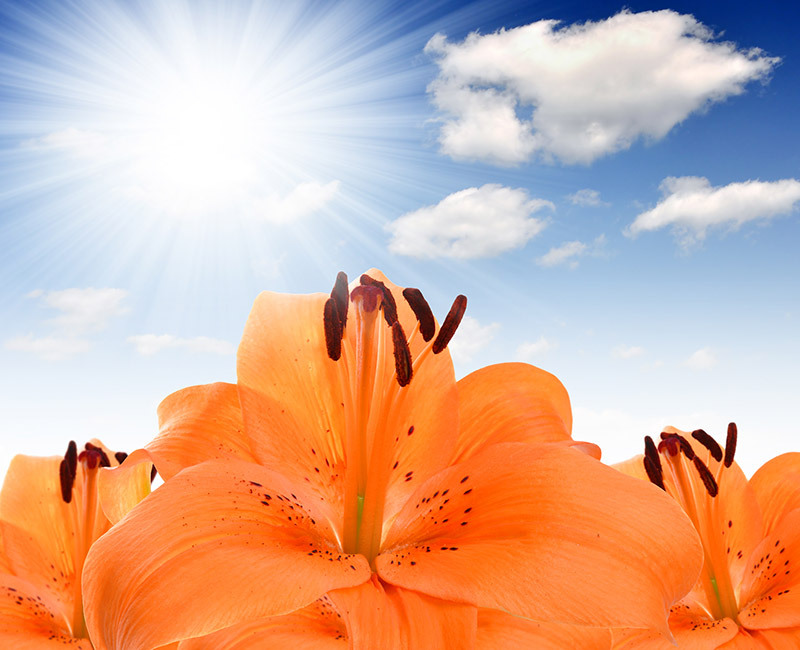Long-Lasting Poinsettias: From Bloom to Thriving
Posted on 21/08/2025
Long-Lasting Poinsettias: From Bloom to Thriving
Poinsettias (Euphorbia pulcherrima) are cherished holiday favorites, renowned for their vibrant bracts and festive charm each winter. However, many people wonder--can poinsettias be more than just seasonal decor? The answer is a resounding yes! With the right care and knowledge, long-lasting poinsettias can bring color and life to your home for months, or even transition into beautiful, thriving houseplants for years to come.
Understanding Poinsettias: The Iconic Holiday Plant
The modern association of poinsettias with Christmas belies their fascinating origins in the warm regions of Mexico and Central America. Here's what you should know about these captivating plants:
- Plant Family: Poinsettias belong to the Euphorbiaceae family, famous for their striking, colorful bracts (modified leaves).
- "Flowers": The showy red, pink, white, or variegated "petals" are actually bracts--botanical leaf structures that surround the plant's true tiny flowers (cyathia) at the center.
- Symbolism: In Mexico, the plant is called Flor de Nochebuena (Christmas Eve Flower), symbolizing purity and celebration.
- Bloom Time: In their native habitat, poinsettias bloom in winter as day length shortens.

Choosing Healthy, Long-Lasting Poinsettias
Achieving long-lasting poinsettias begins at the greenhouse or garden center. If you want your poinsettia plants to thrive well past the holiday season, it's crucial to select healthy specimens. Here's how:
- Check the Bracts: Look for vibrant, unblemished bracts. Fading, curling, or spotted bracts signal poor health or age.
- Inspect the True Flowers: The tiny, yellow flowers (cyathia) at the center should still be tight and unopened--open or falling flowers suggest the plant is past its peak and might not last as long.
- Leaf Quality: Choose plants with deep green, lustrous leaves down to the soil--no yellowing, spots, or wilting.
- Root Health: Gently lift the pot (if possible) to check for strong roots peeking from the base, but not root-bound or waterlogged.
- No Pests: Watch for signs of whiteflies, spider mites, or sticky residue that suggests infestations.
Pro Tip:
Large, bushy poinsettias with more branches and blooms typically outlast smaller, spindly plants.
Ideal Environment: Making Poinsettias Last
Providing optimal conditions is the secret to keeping your poinsettia plant thriving longer. Here's what to focus on:
1. Light
- Location: Poinsettias need bright, indirect sunlight. A north- or east-facing window is ideal.
- Warning: Direct sunlight can scorch the leaves and bracts, causing premature color loss.
2. Temperature
- Preferred Range: Maintain indoor temperatures between 60-70?F (15-21?C) during the day.
- Night Chill: Cooler nights (55?F/13?C) can extend bloom life, but never allow exposure to frost.
- Steer Clear of: Cold drafts, hot air vents, radiators, or fireplaces--the sudden temperature swings will stress your poinsettia and shorten its life.
3. Humidity
- Poinsettias prefer moderate humidity (40-60% relative humidity).
- If air is too dry, especially in winter-heated homes, place a tray of pebbles and water near the plant or use a small humidifier nearby.
4. Watering
- Water thoroughly when the soil surface feels dry to the touch, but don't let the pot stand in water.
- Drainage is essential: excess water kills roots, turns leaves yellow, and causes early leaf drop.
- Empty decorative pot covers and saucers promptly after watering.
5. Fertilizing
- While flowering, poinsettias typically do not need feeding.
- Start a balanced, water-soluble fertilizer (like 20-20-20) only after the blooms fade, about every 3-4 weeks during active growth.
Extending Poinsettia Color: Post-Bloom Care
Want to keep your poinsettia colorful and lovely for as long as possible? Here are expert tips for extending poinsettia blooms well past the holidays:
- Pinch Off Faded Bracts: As older bracts lose vibrancy or wither, gently remove them to redirect energy to healthy parts of the plant.
- Avoid Sudden Moves: Changes in environment can trigger shock and leaf drop--move your poinsettia only if necessary.
- Monitor Water Closely: Drying out or soggy soil are the top killers of holiday poinsettias.
- Prune Lightly: Once blooming is done and bracts start to fade, cut stems back by 1/3 to encourage fuller growth.
Remember: Even as the famous red (or white, pink) bracts eventually fade, healthy green foliage can remain lush for many months if cared for properly.
Poinsettia Troubleshooting: Common Issues & Solutions
1. Leaf Drop
- Cause: Sudden temperature shifts, drafts, incorrect watering, or moving the plant abruptly.
- Solution: Keep environment stable, water only when needed, and avoid exposing the plant to cold or hot blasts of air.
2. Leaves Turning Yellow
- Cause: Overwatering, root rot, or poor drainage.
- Solution: Let the soil partially dry between waterings, be sure pots have drainage holes, and remove any excess water.
3. Pale or Fading Bracts
- Cause: Insufficient light, age, or poor nutrition.
- Solution: Provide more indirect light and consider gentle feeding once blooming ceases.
4. Pest Infestation
- Common Culprits: Whiteflies, spider mites, or aphids.
- Solution: Isolate affected plants, rinse leaves in lukewarm water, or treat with insecticidal soap.
Transitioning Your Poinsettia to a Year-Round Plant
After the winter showcase, most people discard their poinsettias. However, the plant can easily become a lovely, long-lasting houseplant or even be prepped for reblooming next year. Here's how:
Spring and Summer Care
- Prune: When bracts fade and drop, cut the plant back to about 6 inches tall, keeping a few leaves per stem.
- Relocate: Move your plant to a brighter spot indoors.
- Water and Feed: Resume regular watering, and start feeding every 3-4 weeks with balanced fertilizer.
- Repot: In late spring, repot into fresh, well-draining potting mix if roots are tightly packed or growth seems slow.
- Outdoors: In zones 9-11, acclimate the plant to outdoor conditions when temperatures are consistently above 55?F (13?C).
Encouraging Rebloom for Next Holiday Season
- Photoperiodism: Poinsettia plants bloom (produce colored bracts) in response to shorter days.
- Starting in Fall (late September): Provide complete darkness for at least 14 hours nightly for about 8-10 weeks. Cover the plant or move it to a dark closet from evening until morning.
- During the Day: Return plant to bright, indirect light.
- Result: In November/December, new colorful bracts will develop for a second season of bloom!
Creative Ways to Enjoy Long-Lasting Poinsettias All Year
Far from being "disposable" plants, poinsettias can enhance your home or office in many beautiful, creative ways all year round:
- Mixed Holiday Planters: Combine with winter greenery, cyclamen, orchids, or amaryllis for a living festive arrangement.
- Spring Greenery: As colored bracts fade, pot with trailing ivy or ferns for a fresh green centerpiece.
- Outdoor Features: In frost-free climates, established plants make gorgeous, brightly colored shrubs or hedges outside all spring and summer.
- Propagate: Take cuttings from healthy plants in spring to grow next year's poinsettias yourself--an affordable, rewarding project!
- Gift Giving: Present a thriving, lush green poinsettia as a living gift for birthdays, housewarmings, or thank-you gestures.

FAQs on Long-Lasting Poinsettias
Are poinsettias poisonous to pets?
Good news: Poinsettias are not as dangerous as often believed. The plant's sap may irritate sensitive mouths or cause mild tummy upset in pets, but serious poisoning is rare. Still, it's best to keep out of reach of curious animals.
Can I plant my poinsettia outside?
Yes, in USDA zones 9-11, poinsettias can live outdoors all year, becoming large, spectacular shrubs. In colder climates, grow indoors or bring inside before the first frost.
What causes leaf drop right after I bring my poinsettia home?
Sudden environmental changes (temperature, humidity, or light) shock the plant, causing leaf drop. Try to mimic the nursery conditions and avoid exposing the plant to drafts or hot/cold spots.
How can I encourage denser growth?
Regular light pruning (pinching back tips in late spring and summer) helps your poinsettia become bushier and fuller, making for a more robust display next holiday season.
Conclusion: The Secret to Long-Lasting Poinsettias
With a little attention and understanding, poinsettias can be more than just a fleeting winter decoration. From selecting the healthiest plants, providing ideal care, and gently transitioning them into year-round houseplants, you'll discover that long-lasting poinsettia plants are within every gardener's reach.
Remember, long-lasting poinsettias not only add cheer to your winter days but can brighten your home all year long--making them a true botanical treasure.
May your poinsettias thrive, bloom, and bring joy from season to season!
Latest Posts
7 Unexpected Facts About Tulips to Explore
Long-Lasting Poinsettias: From Bloom to Thriving
Harness the Power of Orchids at Home







